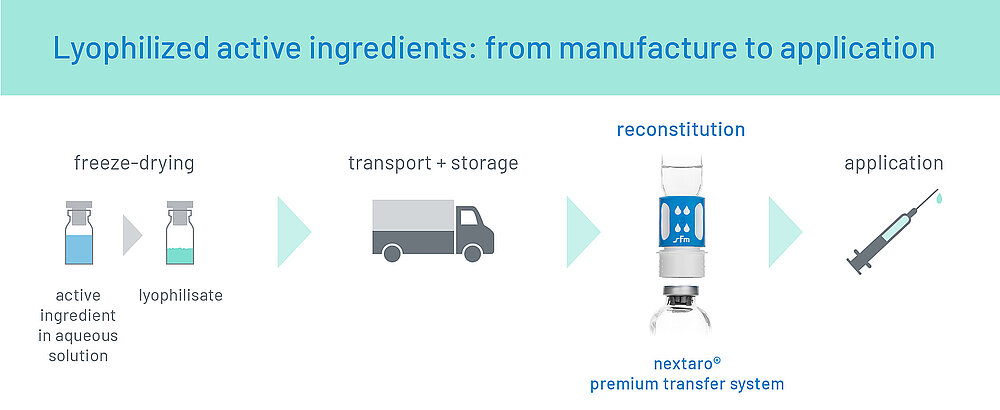Advantages and applications of lyophilized medications
Freeze-drying has proven to be effective for preservation in the manufacture of sensitive biopharmaceutical products. The requirements of this complex process are high. Lyophilized active ingredients have several advantages. What are they, and what factors need to be considered during reconstitution?

Production of lyophilized active ingredients
Freeze-drying (lyophilization) has been an important step in the manufacture and development of pharmaceutical drugs since the beginning of the 21st century.1 As a basic principle, water is withdrawn from the solution of the active ingredient. Lyophilization affects the product quality in many ways: chemical and physical degradation reactions are slowed down or even completely stopped in the freeze-dried state. This results in improved long-term stability. Freeze drying has become the most common formulation of biopharmaceutical medications in recent years.1
The lyophilization process
Lyophilization is a complex process, and the relevant processes must be optimized for the respective medication. Several stages are involved:2
- Cold: The aqueous solution of the active ingredient freezes in the vial. This step is a prerequisite for low-temperature drying.
- Vacuum: In a vacuum, the frozen solvent vaporizes without passing through a liquid phase (sublimation).
- Heat: Raising the temperature accelerates sublimation.
- Condensation: The vaporized solvent condenses on the walls of the vacuum chamber and is removed. This completes the separation process.3
The result is a virtually anhydrous, freeze-dried cake of the medication.1
Advantages of lyophilized active ingredients
Freeze-drying is worthwhile because lyophilized active ingredients have several useful advantages:
- The chemical and biochemical properties of the active ingredient remain unchanged due to the gentle freeze-drying process.
- The freeze-dried medication cake remains sterile and stable in the vial for a long time while in storage.
- Transport and storage are simplified by the small footprint.
A decisive advantage of lyophilized substances can be seen in the reconstitution of the active ingredient. This is because the porous structure of lyophilized active ingredients ensures that they dissolve quickly in an aqueous solution. However, there are high demands on the transfer system.
Reconstitution
Reliable and gentle reconstitution is important in order to protect the high-quality medication that has passed through the complex lyophilization process. Incorrect reconstitution can lead to a loss of quality or even render the solution of active ingredient useless. In addition to the safety issues for the patient, this can also have negative economic effects. The nextaro® premium transfer system from sfm medical devices GmbH reconstitutes the lyophilizate gently and completely due to its special geometry. In addition, nextaro® can be adapted to the individual characteristics of the components to optimize the reconstitution process. The result is a high-quality solution containing the active ingredient that is ready for injection.

References:
- Nireesha GR, Divya L, Sowmya C et al. Lyophilization/Freeze Drying - An Review. International Journal of Novel Trends in Pharmaceutical Sciences 2013; 3: 87-98. https://www.scienztech.org/index.php/ijntps/article/view/96
- Kawasaki H, Shimanouchi T, Kimura Y. Recent Development of Optimization of Lyophilization Process. Journal of Chemistry 2019; 2019: 9502856. https://doi.org/10.1155/2019/9502856
- Kuu WY, Hardwick LM, Akers MJ. Correlation of laboratory and production freeze drying cycles. Int J Pharm 2005; 302: 56-67. https://www.ncbi.nlm.nih.gov/pubmed/16099610